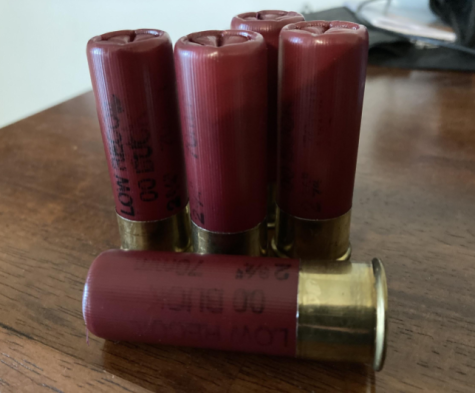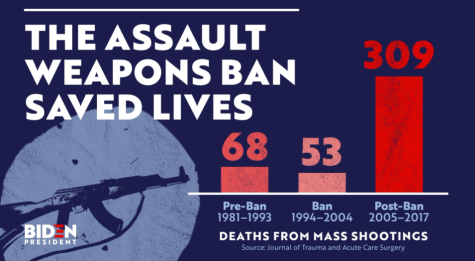An attack on freedom sitting in dust: Assault weapons ban bill stagnates
The Assault Weapons Ban of 2022 has yet to pass in the U.S. Senate. (Public Domain)
September 30, 2022
Assault weapons ownership is one of the most boldly fought issues that the American legislature has faced time and time again. This time, Senate Democrats may have the chance to nail it dead for good.
On September 22, after facing countless mass shootings over the past months (most notably the mass shooting that took place in Uvalde, Texas), victims, family members, and activists took to the District of Columbia to advocate for change. Parents of victims lambasted Washington for its indecisiveness on a solution to combat what they call a mass-shooting epidemic.
Politicians have rushed to find ways to address this major issue, with the effort culminating in the announcement of Biden’s Safer America Plan. The plan outlines how the White House will decrease and prevent crime. Most notably–and significantly to some Americans–the plan addresses a ban on assault weapons.
House Democrats have already passed an assault weapons bill along party lines. The bill now sits idle in the Senate. Senate Democrats would need to work across the aisle with at least 10 Republicans to get the bill passed.
While many have a very rigid point of view on the topic, few really know the history of the term and the previous laws in place before it. So, for a better understanding of the law and the coining of the term, here is an in-depth look into the history of the acclaimed assault rifle.
Terminology

The term “assault rifle” unsurprisingly originates from a country which can historically be linked to the term “assault.” Nazi Germany named one of their most infamous weapons the Sturmgewhr. Roughly translated, this name means assault rifle.
Many falsely believe the term comes from the AR-15, one of the most well-known and purchased assault rifles in the U.S. The belief comes from the assumption that the A stands for assault. Rather, it stands for the manufacturer of the AR-15, ArmaLite.
Currently, the term may fall under a different definition depending on which side of the aisle one stands on. Pro-gun advocates like the National Rifle Association (NRA) define assault rifles as “a selective-fire rifle chambered for a cartridge of intermediate power.”
On the other hand, groups like BradyUnited define them as “firearms with tactical designs developed for military use that automatically fire and reload a new bullet every time the trigger is pulled.” The key difference here is the inclusion of purely semi-automatic weapons as a part of the assault rifle branch.
Lethality
When it really comes down to it, all guns are dangerous. Whether or not a gun has a bump stock, fore grip or red dot sight does not change the projectile that comes out of the barrel.

For a better comprehension, the firearm that President Joe Biden suggests Americans use (a 12-gauge double-barrel shotgun) fires a larger cartridge than any popular assault rifle. The shotgun is also capable of firing multiple projectiles at a single time.
Not convinced? Then look back in time to 1918. The trench shotgun was so excruciatingly painful that Germany asked America to stop using them in World War I because of the “unnecessary suffering” they caused. Ironically, this is the same Germany that utilized the devastating chlorine gas in concentration camps.
The main argument about the dangerousness of assault weapons stems from their ability to utilize magazines of varying sizes. This enables the weapon to use high-capacity magazines, which are magazines that can hold a large quantity of ammunition, thus allowing a shooter to sustain gunfire for longer periods of time.
History
In the early 90s, politicians were struggling with how to deal with a massive crime wave. One of the many solutions they put into action was the “Public Safety and Recreational Firearms use Protection Act.” The bill banned assault weapons from ’94 to ’04.

After 2004, multiple attempts were made to reestablish the ban, with every attempt failing to pass in both houses.
While many claim the ban was successful in its attempt to stem gun violence, the statistics can be better explained when examined under better light. For example, there is no debate that gun violence did see a decrease while the ban was active. What is left out is the clear decrease in gun violence already occuring before the ban took place.
Importance
Some consider this issue a slippery slope. A permanent ban on assault weapons could spell problems for hundreds of gun owners across America. Though the bill does include a grandfather clause which allows current assault weapon owners to keep said firearms, the bill will weaken the freedoms accessible to all Americans.
It is also important to realize that the officials deciding these gun laws are, at times, misinformed.
In a statement about the 2nd Ammendment, Biden said, “From the day it was passed, the Second Amendment limited the type of people who could own a gun and what type of weapon one could own. You couldn’t buy a cannon.”
It was, in fact, legal to own a cannon both before and after the constitution was written. There were also no laws at the time limiting the type of firearms a person could own.
Will it pass?
The simple answer is likely no. However, that does not really tell the whole story. With an upcoming election cycle that could see both chambers flip blue or red, it may really come down to a few elections. As with the current 50 (Republican) /49 (Democrat) /1 (Independant) split in the Senate, parties are physically forced to work across the aisle. With the Senate sitting on the bill for so long, it seems they may hope to sit on this until another string of mass shootings occur that will force them to again move at their snails pace. Additionally, the Senate is sitting on another gun-related bill that would increase the strength of an aging background check system that has time and time again failed.
So, rather than sit and let politicians play turtle, encourage Maryland senators Ben Cardin and Chris Van Hollen to act. Even if one disagrees with their point of views against guns, the least one could do is ask for them to start a conversation on the matter so we can finally find a solution to this growing issue in American politics.



